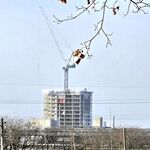Initial estimate pegs cost of waterfront transit plan at $1.9 to $2.3 billion
The city's future plans for transit along its waterfront study is shown in this image. (City of Toronto)
Chris Fox, CP24.com
Published Wednesday, January 17, 2018 12:01PM EST
Last Updated Wednesday, January 17, 2018 12:36PM EST
An ambitious plan to improve transit along the city’s waterfront carries a price tag of $1.98 to $2.31 billion in 2017 dollars, according to a staff report.
The
report, which will go before the city’s executive committee next week, lays out 10 proposed transit projects for an area spanning from Long Branch Avenue and Lakeshore Boulevard in the west end to Queen Street and Woodbine Avenue in the east end.
Included in the list of projects is a long-discussed light-rail transit line along Queen’s Quay between Bay and Parliament streets and another light rail line between Exhibition Place and the Humber Bay Shores area dubbed the "Humber Bay Link."
Staff are also recommending infrastructure improvements that would allow streetcars to operate in a dedicated lane on parts of Lakeshore Boulevard, Bathurst Street and Cherry Street.
The staff report follows the completion of a phase one study, which took a closer look at which transit projects would be the most beneficial for the area. The phase one study was completed in 2016.
“Our Etobicoke waterfront has exploded with development. People want to live here, but our transit has not kept up,” Mayor Tory said in a press release issued on Wednesday, in which he highlighted the proposed projects for the west end. “We have a plan for transit solutions across the entire length of the waterfront to get Toronto moving. We are getting on with it and I'm confident we will get it built.”
Staff are recommending that the city pursue the projects included in the plan as part of a wider waterfront transit network that they says is necessary in light of the significant population growth expected to take place in the neighbourhoods bordering Lake Ontario.
The staff report says that the population in the study area is forecast to increase by 280,000 people by 2041 while the number of jobs will increase by an estimated 190,000.
The report says that the transit infrastructure serving the city’s waterfront currently is simply “inadequate to accommodate latent and future” demand, particularly in rapidly growing communities like Liberty Village, Humber Bay Shores, the Lower Don Lands and the Union Station-East Bayfront area.
“Overall, an extended TTC light rail transit service network along the waterfront would serve multiple roles – longer distance trips, local trips, recreational/cultural/special event-based trips, and connections to other sustainable transportation modes, providing a resilient and flexible transportation system for the 21st century, the report states.
The city previously included the waterfront transit network among its priority projects for the second phase of federal public transit infrastructure funding.
The report going before executive committee next week asks that the updated network plan be included in the city’s official plan and be forwarded to Metrolinx for consideration as part of their ongoing regional transit review.
Though most of the projects included in the plan are at one per cent design or less, the report notes that work is currently underway to advance the design work to the 30 per cent threshold on both the Queen’s Quay and Humber Bay Shores LRT’s.
The report also warns that the estimated budget of $1.98 to $2.31 billion is subject to "further design work" and "third party cost estimate validation."
"These costs are primarily based on one per cent or less level of design," it states. This estimate does not include escalation, financing costs or the pricing of risk."





